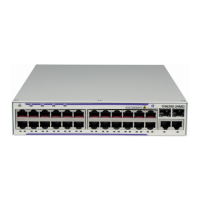LDP Configuration Commands
7210 SAS M, T, X, R6, Mxp MPLS Configuration Guide Page 283
The no form of the command deletes the LDP interface and all configuration information associated
with the LDP interface.
The LDP interface must be disabled using the shutdown command before it can be deleted.
Parameters ip-int-name — The name of an existing interface. If the string contains special characters (#, $,
spaces, etc.), the entire string must be enclosed within double quotes.
bfd-enable
Syntax bfd-enable
no bfd-enable
Context config>router>ldp>interface-parameters>interface
This command enables tracking of the Hello adjacency to an LDP peer using BFD.
When this command is enabled on an LDP interface, LDP registers with BFD and starts tracking the
LSR-id of all peers it formed Hello adjacencies with over that LDP interface. The LDP hello
mechanism is used to determine the remote address to be used for the BFD session. The parameters
used for the BFD session, that is, transmit-interval, receive-interval, and multiplier are those
configured under the IP interface in existing implementation: config>router>interface>bfd
When multiple links exist to the same LDP peer, a Hello adjacency is established over each link and a
separate BFD session is enabled on each LDP interface. If a BFD session times out on a specific link,
LDP will immediately associate the LDP session with one of the remaining Hello adjacencies and
trigger the LDP FRR procedures. As soon as the last Hello adjacency goes down due to BFD timing
out, the LDP session goes down and the LDP FRR procedures will be triggered.
The no form of this command disables BFD on the LDP interface.
Default no bfd-enable
transport-address
Syntax transport-address {interface | system}
no transport-address
Context config>router>ldp>if-params
config>router>ldp>if-params>if
Description This command configures the transport address to be used when setting up the LDP TCP sessions.
The transport address can be configured as interface or system. The transport address can be
configured globally (applies to all LDP interfaces) or per interface. The most specific value is used.
With the transport-address command, you can set up the LDP interface to the connection which can
be set to the interface address or the system address. However, there can be an issue of which address
to use when there are parallel adjacencies. This situation can not only happen with parallel links, it
could be a link and a targeted adjacency since targeted adjacencies request the session to be set up
only to the system IP address.
Note that the transport-address value should not be interface if multiple interfaces exist between
two LDP neighbors. Depending on the first adjacency to be formed, the TCP endpoint is chosen. In

